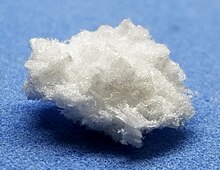Pyrogallol

| |

| |

| |
| Names | |
|---|---|
| Preferred IUPAC name
Benzene-1,2,3-triol | |
| Other names | |
| Identifiers | |
3D model (JSmol)
|
|
| ChEBI | |
| ChEMBL | |
| ChemSpider | |
| ECHA InfoCard | 100.001.603 |
| EC Number |
|
| KEGG | |
PubChem CID
|
|
| RTECS number |
|
| UNII | |
| UN number | 2811 |
CompTox Dashboard (EPA)
|
|
| |
| |
| Properties | |
| C6H6O3 | |
| Molar mass | 126.11 g/mol |
| Density | 1.453 g/cm3 (4 °C)[1] |
| Melting point | 125.5 °C (257.9 °F; 398.6 K)[1] |
| Boiling point | 307 °C (585 °F; 580 K)[1] |
Refractive index (nD)
|
1.561 (134 °C)[1] |
| Structure[2] | |
| Monoclinic | |
| P21/n | |
a = 12.1144(11) Å, b = 3.7765(3) Å, c = 13.1365(12) Å α = 90°, β = 115.484(1)°, γ = 90°
| |
Formula units (Z)
|
4 |
| Hazards | |
| GHS labelling: | |
 
| |
| Warning | |
| H302, H312, H332, H341, H412 | |
| P201, P202, P261, P264, P270, P271, P273, P280, P281, P301+P312, P302+P352, P304+P312, P304+P340, P308+P313, P312, P322, P330, P363, P405, P501 | |
Except where otherwise noted, data are given for materials in their standard state (at 25 °C [77 °F], 100 kPa).
| |
Pyrogallol is an organic compound with the formula C6H3(OH)3. It is a water-soluble, white solid although samples are typically brownish because of its sensitivity toward oxygen.[3] It is one of three isomers of benzenetriols.
Production and reactions
It is produced in the manner first reported by Scheele in 1786: heating gallic acid to induce decarboxylation.[3]
Gallic acid is also obtained from tannin. Many alternative routes have been devised. One preparation involves treating para-chlorophenoldisulfonic acid with potassium hydroxide,[4] a variant on the time-honored route to phenols from sulfonic acids.[5]
Polyhydroxybenzenes are relatively electron-rich. One manifestation is the easy C-acetylation of pyrogallol.[6]
Uses
It was once used in hair dyeing, dyeing of suturing materials. It also has antiseptic properties.
In alkaline solution, pyrogallol undergoes deprotonation. Such solutions absorb oxygen from the air, turning brown. This conversion can be used to determine the amount of oxygen in a gas sample, notably by the use of the Orsat apparatus. Alkaline solutions of pyrogallol have been used for oxygen absorption in gas analysis.
Use in photography
Pyrogallol was also used as a developing agent in the 19th and early 20th centuries in black-and-white developers. Hydroquinone is more commonly used today. Its use is largely historical except for special purpose applications. It was still used by a few notable photographers including Edward Weston. In those days it had a reputation for erratic and unreliable behavior, due possibly to its propensity for oxidation. It experienced a revival starting in the 1980s due largely to the efforts of experimenters Gordon Hutchings and John Wimberley. Hutchings spent over a decade working on pyrogallol formulas, eventually producing one he named PMK for its main ingredients: pyrogallol, Metol, and Kodalk (the trade name of Kodak for sodium metaborate). This formulation resolved the consistency issues, and Hutchings found that an interaction between the greenish stain given to film by pyro developers and the color sensitivity of modern variable-contrast photographic papers gave the effect of an extreme compensating developer. From 1969 to 1977, Wimberley experimented with the Pyrogallol developing agent. He published his formula for WD2D in 1977 in Petersen's Photographic. PMK and other modern pyro formulations are now used by many black-and-white photographers. The Film Developing Cookbook has examples.[7]
Another developer mainly based on pyrogallol was formulated by Jay DeFehr. The 510-pyro,[8] is a concentrate that uses triethanolamine as alkali, and pyrogallol, ascorbic acid, and phenidone as combined developers in a single concentrated stock solution with long shelf life . This developer has both staining and tanning properties and negatives developed with it are immune to the callier effect. It can be used for small and large negative formats.
The Darkroom Cookbook (Alternative Process Photography) has examples.[9]
Safety
Pyrogallol use, e.g. in hair dye formulations, is declining because of concerns about its toxicity.[10] Its LD50 (oral, rat) is 300 mg/kg.[3]
Isolated, pyrogallol was found to be extremely genotoxic in vitro, but certain compounds in the body may protect against its toxicity.[11][12]
See also
- Catechol
- Gallacetophenone (2,3,4-trihydroxyacetophenone)
- Gallic acid
- Syringol
References
- ^ a b c d e Haynes, William M., ed. (2016). CRC Handbook of Chemistry and Physics (97th ed.). CRC Press. p. 3.38. ISBN 9781498754293.
- ^ Thakuria, Ranjit; Cherukuvada, Suryanarayan; Nangia, Ashwini (2012). "Crystal Structures of Pyrogallol, Its Hydrate, and Stable Multiple Z ′ Cocrystals with N-Heterocycles Containing Metastable Conformers of Pyrogallol". Crystal Growth & Design. 12 (8): 3944–3953. doi:10.1021/cg3003367.
- ^ a b c Fiege, Helmut; Heinz-Werner, Voges; Hamamoto, Toshikazu; Umemura, Sumio; Iwata, Tadao; Miki, Hisaya; Fujita, Yasuhiro; Buysch, Hans-Josef; Garbe. "Ullmann's Encyclopedia of Industrial Chemistry". Ullmann's Encyclopedia of Industrial Chemistry. Weinheim: Wiley-VCH. p. 1072. doi:10.1002/14356007.a19_313. ISBN 978-3527306732.
- ^ Buzbee, Lloyd R. (1966-10-01). "Rearranged Products from the Reaction of Benzenesulfonic Acids with Caustic". The Journal of Organic Chemistry. 31 (10): 3289–3292. doi:10.1021/jo01348a042. ISSN 0022-3263.
- ^ Magro, Angel A. Núñez; Eastham, Graham R.; Cole-Hamilton, David J. (2009-06-10). "Preparation of Phenolic Compounds by Decarboxylation of Hydroxybenzoic Acids or Desulfonation of Hydroxybenzenesulfonic Acid, Catalysed by Electron Rich Palladium Complexes". Dalton Transactions (24): 4683–8. doi:10.1039/B900398C. ISSN 1477-9234. PMID 19513476.
- ^ Badhwar, I. C.; Venkataraman, K. (1934). "Gallacetophenone". Organic Syntheses. 14: 40. doi:10.15227/orgsyn.014.0040.
- ^ Anchell, Stephen G.; Troop, Bill (1998). The Film Developing Cookbook. ISBN 978-0240802770.
- ^ "510-PYRO". 510-PYRO.
- ^ Anchell, Stephen, G. (2016). The darkroom cookbook (Fourth ed.). New York. ISBN 9781138959187. OCLC 938707611.
{{cite book}}: CS1 maint: location missing publisher (link) CS1 maint: multiple names: authors list (link) - ^ "Safety data for 1,2,3-trihydroxybenzene". Archived from the original on 2009-02-28. Retrieved 2009-03-05.
- ^ "Cancer Biologists Find DNA-Damaging Toxins in Common Plant-Based Foods". Johns Hopkins Medicine. Retrieved 11 February 2024.
- ^ "Compounds in Saliva and Common Body Proteins May Fend Off DNA-Damaging Chemicals in Tea, Coffee and Liquid Smoke". Johns Hopkins Medicine. Retrieved 11 February 2024.
- CS1 maint: location missing publisher
- CS1 maint: multiple names: authors list
- Articles with short description
- Short description matches Wikidata
- ECHA InfoCard ID from Wikidata
- Chembox having GHS data
- Articles containing unverified chemical infoboxes
- Chembox image size set
- Short description is different from Wikidata
- Articles with GND identifiers
- Pyrogallols
- Antioxidants
- Catechols
- Chelating agents
- Photographic chemicals
- Reducing agents
